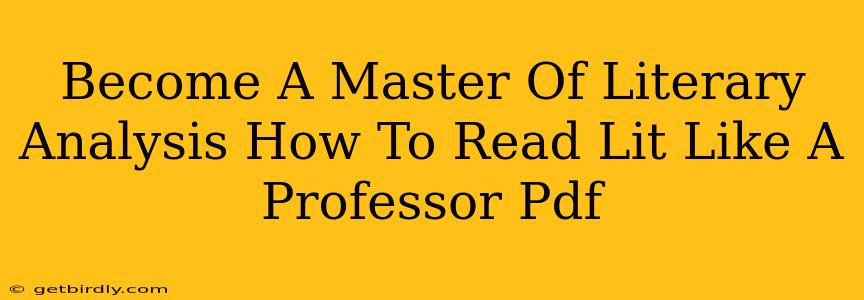Become a Master of Literary Analysis: "How to Read Lit Like a Professor" (And Beyond)
For years, Thomas C. Foster's How to Read Literature Like a Professor has been a cornerstone text for literature students and enthusiasts alike. Its approachable style and insightful analysis have demystified the complexities of literary interpretation, empowering readers to delve deeper into the texts they love (or even those they initially find challenging). While a PDF version might be circulating online, the value of owning the physical book or purchasing an ebook remains, providing access to the complete, unaltered work. This article will explore the core tenets of Foster's approach and extend those principles, offering a roadmap to mastering literary analysis beyond the confines of the book.
What Makes "How to Read Lit Like a Professor" So Effective?
Foster's genius lies in his ability to bridge the gap between academic literary theory and everyday reading experience. He doesn't bombard the reader with dense jargon but instead employs engaging storytelling and relatable examples to illustrate key literary concepts. He teaches readers to "read between the lines," to uncover the subtle nuances and underlying meanings embedded within the text. This is achieved by focusing on recurring motifs, symbols, and narrative structures that transcend individual works and contribute to a broader understanding of literature as a whole.
Key Concepts Explored in Foster's Book (and How to Apply Them)
Foster explores a vast range of literary devices and techniques, including:
Symbols and Symbolism: What Do They Really Mean?
Foster emphasizes the importance of understanding how symbols function within a specific text, rather than relying on pre-conceived notions or generalized interpretations. He encourages readers to consider the context, the author's intentions, and the evolving meaning of symbols throughout the narrative. For example, a recurring image of a journey might symbolize personal growth or a quest for self-discovery.
Archetypes and Myths: Unveiling Universal Patterns
Foster delves into the significance of archetypes – recurring characters, patterns, or symbols that appear across different cultures and time periods. Recognizing these archetypes helps us understand the deeper, universal themes and anxieties explored in literature. Understanding the influence of mythology on narratives enhances our appreciation of symbolism and thematic resonance.
Allusions and Intertextuality: Connecting the Dots
Recognizing allusions to other works of literature, history, or mythology enriches our understanding of a text. Foster highlights the importance of intertextuality – the way texts interact with and build upon one another. Recognizing these connections reveals hidden layers of meaning and expands our literary horizons. This requires a broad understanding of literature and culture, something that can be cultivated through continued reading.
The Importance of Genre: Understanding the Rules of the Game
Every genre operates under a set of conventions and expectations. Understanding these conventions helps us interpret texts more effectively. For instance, knowing the typical tropes of a mystery novel allows for a deeper engagement with the plot twists and character motivations.
Beyond the Book: Expanding Your Literary Analysis Skills
While Foster's book provides a fantastic foundation, true mastery of literary analysis requires ongoing effort and exploration. Here's how to expand beyond the book:
Engage with Critical Essays: Exploring Diverse Interpretations
Reading critical essays on the works you're studying exposes you to diverse perspectives and interpretive approaches. This fosters critical thinking and encourages you to develop your own analytical framework.
Practice Active Reading: Note-Taking and Annotation
Active reading involves engaging with the text through note-taking, annotating, and formulating questions. This creates a deeper understanding of the narrative and allows for more effective analysis.
Compare and Contrast Texts: Identifying Common Threads
Comparing and contrasting different works of literature helps identify common themes, recurring motifs, and stylistic similarities or differences. This enhances analytical skills and expands interpretive horizons.
Develop Your Own Critical Voice: Formulating Original Insights
Ultimately, the goal is to develop your own unique voice and critical perspective. This involves formulating original arguments and interpretations, supported by evidence from the text and informed by your broader understanding of literary theory.
Conclusion: The Ongoing Journey of Literary Exploration
How to Read Literature Like a Professor serves as an excellent starting point, but becoming a true master of literary analysis is an ongoing journey. By actively engaging with texts, exploring diverse critical perspectives, and honing your analytical skills, you can unlock the rich tapestry of meaning hidden within the world of literature. The journey is rewarding, enriching, and constantly evolving—just like our understanding of the art of storytelling itself.

